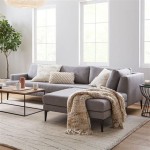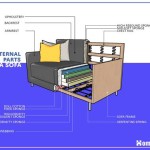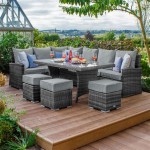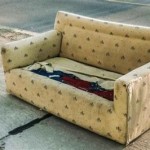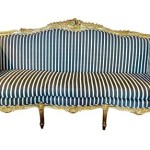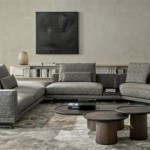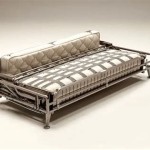The Allure and Functionality of Sofas Without Back Cushions
Sofas without back cushions, also known as backless sofas or platform sofas, represent a significant departure from traditional upholstered seating. This design choice offers a unique aesthetic and functional considerations, impacting everything from room layout to user experience. This article aims to provide a comprehensive overview of sofas without back cushions, exploring their design elements, benefits, drawbacks, common uses, and factors to consider when purchasing one.
Design and Aesthetics
The most striking feature of a sofa lacking back cushions is its minimalist appearance. The absence of traditional back support creates a clean, linear profile, often emphasizing the horizontal lines of the room. This design philosophy aligns with modern and contemporary interior design trends that prioritize simplicity and open space. These sofas often feature a low profile, further contributing to their understated elegance. The result is a piece of furniture that seamlessly blends into its surroundings, rather than dominating the space.
The aesthetic impact of a backless sofa extends beyond its visual simplicity. The exposed wall behind the sofa becomes an integral part of the design. This allows for creative expression through artwork, wallpaper, or textured wall finishes. The wall acts as a visual backdrop, transforming the sofa into a component of a larger, intentionally curated design. Furthermore, the absence of a defined back allows for greater flexibility in terms of accessory placement. Throw pillows can be strategically positioned to provide comfort and visual interest, without being constrained by pre-defined cushion placements.
The structural design of the sofa itself becomes more prominent. The frame, materials, and upholstery are no longer partially obscured by cushions. This necessitates a higher level of craftsmanship and attention to detail in the sofa's construction. The quality of the materials and the precision of the joinery are directly visible, contributing to the overall aesthetic appeal. The emphasis shifts from the softness of the cushions to the beauty of the sofa's underlying form.
Functional Advantages and Disadvantages
The lack of a traditional backrest influences the practical function of the sofa. One key advantage is the increased sense of openness and flow within a room. Without the visual barrier of a high back, the sofa allows for uninterrupted sightlines, making the space feel larger and more connected. This is particularly beneficial in smaller living areas or open-concept homes where maximizing the feeling of spaciousness is a priority.
The absence of a fixed back also offers greater flexibility in terms of seating arrangement. Individuals can sit facing any direction, fostering more interactive and fluid conversations. This makes backless sofas ideal for social gatherings and spaces where adaptability is valued. The sofa can easily transition from a seating area for conversation to a comfortable spot for lounging, simply by adjusting the position of throw pillows or adding a side table.
However, the lack of back support can also present certain drawbacks. Individuals who require significant lumbar support may find a backless sofa uncomfortable for extended periods. The user must rely on throw pillows or alternative seating arrangements to achieve adequate back support. This necessitates a conscious effort to accessorize the sofa with appropriate cushions and pillows to ensure comfortable seating.
Another potential disadvantage is the lack of a defined headrest. Individuals who enjoy reclining or leaning back while watching television or reading may find the absence of a headrest to be a significant inconvenience. This can be mitigated by strategically placing large, supportive pillows along the wall behind the sofa, but this requires careful consideration of pillow size, shape, and density.
Material Considerations and Upholstery
The selection of materials for a backless sofa is crucial, as the structural elements are more exposed and contribute significantly to the overall aesthetic. The frame is typically constructed from hardwood or metal, providing a sturdy and durable foundation. The type of wood or metal used will influence the sofa's overall style and durability. Hardwoods such as oak, maple, or walnut offer superior strength and a rich, warm aesthetic. Metal frames, often made from steel or aluminum, provide a sleek and modern look.
Upholstery choices are equally important. Fabric options range from natural fibers like linen and cotton to synthetic materials like polyester and microfiber. Leather is another popular choice, offering durability and a luxurious feel. The selection of upholstery material should be based on factors such as durability, stain resistance, and aesthetic preference. Lighter-colored fabrics can brighten a room, while darker colors can create a more intimate and sophisticated atmosphere.
Frame construction and upholstery choices influence the sofa's longevity. A well-constructed frame and durable upholstery will ensure that the sofa maintains its appearance and functionality over time. Regular maintenance, such as vacuuming and spot cleaning, is essential for preserving the upholstery's condition and preventing wear and tear. Furthermore, the quality of the foam or springs used in the seating area will impact the overall comfort and support provided by the sofa.
Integrating Backless Sofas into Different Spaces
Backless sofas lend themselves well to a variety of interior design styles and spaces. In minimalist environments, the clean lines and understated design of the sofa complement the overall aesthetic. The sofa can serve as a focal point in the room, while still maintaining a sense of openness and simplicity. In contemporary spaces, the sofa's sleek profile and modern materials align with the overall design aesthetic.
In smaller living areas, a backless sofa can create the illusion of more space. The absence of a visual barrier enhances the flow of light and air, making the room feel larger and less cluttered. The sofa can be positioned against a wall to maximize floor space or placed in the center of the room to define different zones. The flexibility of the design allows for creative space planning and optimization.
Backless sofas can also be successfully integrated into larger, more eclectic environments. The sofa can be used as a neutral backdrop for more colorful and patterned accessories. The simplicity of the design allows it to blend seamlessly into a variety of design schemes, while still providing a comfortable and functional seating area. The key is to carefully select accessories that complement the sofa's design and enhance the overall aesthetic of the room.
Factors to Consider Before Purchasing
Before investing in a sofa without back cushions, several factors should be carefully considered. The first is the intended use of the sofa. If the sofa will be primarily used for lounging and relaxation, the lack of back support may be a significant drawback. However, if the sofa will be used primarily for social gatherings or as a secondary seating area, the flexibility and openness of the design may be preferable.
The size and layout of the room are also important considerations. A large sofa may overwhelm a small space, while a small sofa may be insufficient for a large room. The sofa should be proportionally sized to the room and positioned in a way that optimizes flow and functionality. Consider the placement of other furniture and accessories in the room to ensure a cohesive and balanced design.
Personal preferences and comfort levels are paramount. It is essential to test the sofa's comfort and support before making a purchase. Sit on the sofa for an extended period and experiment with different throw pillow arrangements to determine the optimal level of comfort. Consider the preferences of other members of the household to ensure that the sofa meets the needs of everyone who will be using it.
Budget is another critical factor. Sofas without back cushions can range in price from relatively affordable to quite expensive, depending on the materials, construction, and brand. It is important to set a budget and research different options within that price range. Consider the long-term value of the sofa and prioritize quality and durability over cost savings. A well-constructed sofa will provide years of enjoyment and maintain its appearance over time.
Finally, consider the overall aesthetic of the room and select a sofa that complements the existing décor. Choose a fabric that complements the color scheme and style of the room. Consider the materials and finishes of other furniture and accessories in the room to create a cohesive and harmonious design. The goal is to create a space that is both visually appealing and functionally comfortable.

How Sofa Back Cushions Affect Your Comfort The Stated Home Blog

How Sofa Back Cushions Affect Your Comfort The Stated Home Blog

How To Fix Saggy Couch Cushions An Exercise In Frugality

My 20 Favorite Sofas Elizabeth Street Post

Prado Sofa With Movable Backrests By Werner For Ligne Roset

The Slipcover Maker S Guide To Detaching Back Cushions

Good Morning My Valentines I 39 M Excited To Share This Recent Project Of Mine With You Liv Living Room Sofa Inspiration Style

Cushion Conversations Tight Back Sofas Vs Loose Semi Attached Cushions Woodstock Furniture Mattress

Tillary Modular Seating Modern Sectional Sofas Houzz Sofa

How To Fix Sagging Couch Cushions Thistlewood Farm

